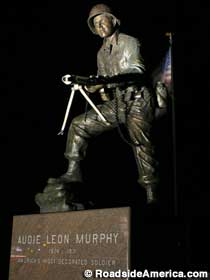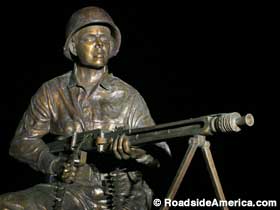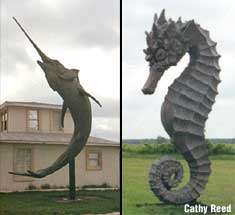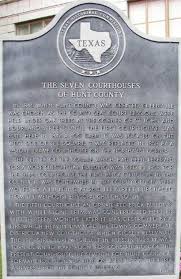For “Travel Tueday”: More about Greenville, TX.
Greenville’s Heritage
“Greenville was carved out of blackland prairie by sturdy pioneers who cleared the tall grass for their homes and farms. When Hunt County was created by the first legislature of the new state of Texas in 1846, Greenville was named the county seat. Our community blends heritage and contemporary lifestyle for the best of both worlds: the city and the country.
Greenville was named for Thomas J. Green, a general in the Texas Army in the war for independence from Mexico and, later, a member of the Congress of the Republic of Texas. (The city narrowly escaped being named “Pinckneyville” in honor of James Pinckney Henderson, the first Governor of Texas!) Hunt County commemorates Memucan Hunt, another Texas freedom fighter and Minister to the United States for the Republic.
The rich blackland soil that stuck to shoes and buggy wheels when wet proved to be a real economic asset. It grew a high quality cotton used by English spinning and weaving mills.
Cotton brought the railroads to Greenville and with them growth and prosperity. The “cotton capital of the world,” Greenville soon boasted the world’s largest inland cotton compress, a population of several thousand and six railway lines.
During the harvest season, cotton brought a “snowfall” to the downtown square as tufts of white pulled from bales for examination by cotton buyers floated into drifts around the courthouse.
As the area began to shift from an agricultural to an industrial economy in the 1950s, Greenville prepared for the future by developing an industrial park. Additional industry grew at the converted World War II Majors Field Army Air Corp base, now serving as the municipal airport.
A former Governor of Texas has stated, “Greenville stands a model of a community that planned smart and worked hard.”
Throughout Greenville’s history, economic growth has been accompanied by attention to the social, spiritual and recreational needs of our citizens. The community’s many civic organizations, churches and city-wide festivals and celebrations are enhanced by the availability of local parks, museums, library, golf courses, and nearby lakes.
The conveniences of an industrialized city, coupled with a “hometown” attitude, make Greenville a great place to work and a great place to live!”
_________ 
1884 August 17 - Fire destroyed Hunt County Courthouse and most of Greenville business district. Size of city increased to two square miles.
1885 6th Hunt County Courthouse built, almost an exact replica of the 5th.
_______
The Seven Courthouses of Hunt County Historical Marker
The historical marker in front of the current courthouse relays the history of the previous Hunt County courthouses. - Terry Jeanson, June 2007 photo
The Seven Courthouses of Hunt County Historical Marker Text:
“In 1846, when Hunt County was created, Greenville was chosen as the county seat. Court sessions were held under oak trees at the corner of St. John and Bourland streets until the first courthouse was built here in 1847. A log cabin, it was located on the west side of the square. It was replaced in 1853 by a 2-story frame courthouse on the northwest corner.
The center of the square, which had been reserved for a more substantial building, was used in 1858 for the third courthouse. The first brick structure in the county, it was condemned in 1874. County offices were moved to a building at 2610 Lee Street, purchased from the Methodist Episcopal Church, South.
The fifth courthouse, an ornate red brick building with white stone trim, was constructed here in 1883. Thirteen months later it was destroyed by a fire which heavily damaged the town's commercial district. A new courthouse, which closely resembled the 1883 structure, was built in 1885. In 1928 it was torn down to make room for construction of the present courthouse, the seventh for Hunt County. A formal dedication was held on April 11, 1929, the 83rd anniversary of the county's founding.”
_______
Historic Preservation
“Greenville’s rich heritage is echoed by historic architecture in its downtown and in residential neighborhoods. Fueled by 19th- and early 20th-century demands for cotton, Greenville grew from settlement to city in a generation. The cotton trade and the money flowing into Greenville also brought banking, entertainment, culture and commerce. From nationally recognized landmarks to quaint cottages, abundant reminders remain of a proud past pointing to a vibrant future. In Greenville, we’re building on our legacy of success.”
_______
Audie Murphy - America's Most Decorated Soldier

Greenville, Texas
"America's Most Decorated Soldier" is rendered in Goliath-size bronze (he was a little guy in life) just off of the interstate, dressed in GI fatigues, 30-caliber machine gun lifted off the ground, ready to blow a bloody path through the Nazi lines. In less than three years of World War II service, Audie Murphy was credited with single-handedly terminating more than 240 German soldiers. This one-man killing machine received every decoration of valor that the United States had to offer, some more than once, as well as five decorations from France and Belgium. And he did it all before he reached the age of 21.

Audie came home to a hero's welcome, starred in Hollywood films, and penned country-western songs ("Shutters and Boards," "When the Wind Blows In Chicago"). But he also suffered from years of shell shock, and from drug addiction to deaden the shell shock, and he died in a plane crash when he was only 46.
Behind the statue is the Audie Murphy/American Cotton Museum. Audie was a humble man, which perhaps explains why this greatest American war hero shares a museum with an agricultural product. “
Audie Murphy/American Cotton Museum
A visit to the Audie Murphy/American Cotton Museum will introduce you to the diversity of the region's colorful past.
Learn about inhabitants of the blackland prairie, and how they contributed to the unique soil that comprises the prairie today. Learn about planting, growing, ginning, baling, spinning, and weaving cotton.
Tour the Ende-Gaillard exhibit and experience the past, brought back to life through historic re-enactment.
The museum proudly displays a newly dedicated ten foot bronze statue of Hunt County native Audie L. Murphy, World War II's most decorated soldier. The Greenville Sesquicentennial Committee commissioned local sculptor Gordon Thomas to create the statue. The Audie Murphy Exhibit includes photos, biographies, uniforms, and military medals to tell the story of the sharecropper's son who left home to become a national hero.
Special features include a fossil & arrowhead collection, two working cotton gin models, Ende-Gaillard parlor vignette, Greenville National Bank exhibit, special temporary exhibits, photograph, and reference files.
The Audie Murphy/American Cotton Museum houses a collection of Audie Murphy memorabilia including photographs, biographies, uniforms and reproductions of medals awarded to the country’s most decorated soldier. Murphy enlisted at the old Greenville Post Office on Lee Street.
Second Lieutenant Audie L. Murphy was awarded the Medal of Honor, the nation’s highest military award, on June 2, 1945. He was just 20 years old. His Medal of Honor citation credits Murphy with holding off two enemy rifle companies, single-handedly, for several hours near a village in eastern France. His 33 medals included three from France and one from Belgium.
At war’s end, Murphy went from the fields of battle to the giant screen, making more than 40 movies, including his own biography, To Hell and Back. The man who was a young hero also died young. He was killed in a plane crash at the age of 46.”
“Learn about famous personalities from Hunt County, such as Monty Stratton, White Sox major league pitcher.
The Audie Murphy/American Cotton Museum's exhibit featuring Greenville resident Monty Stratton, who became a national celebrity with the debut of MGM’s The Stratton Story in 1949, includes memorabilia from his pitching career as well as movie souvenirs.
Stratton, a pitcher for the Chicago White Sox, began his pitching career with an amateur league team in Van Alstyne, Texas, moving up to the White Sox in 1936. His major league pitching career ended in 1938 when, at the age of 26, Stratton lost his right leg in a hunting accident. He returned to the Sox as a pitching coach. In 1946, Stratton returned to the mound with an artificial leg, winning 18 games for the East Texas League Sherman-Denison Twins.
Jimmy Stewart starred as the 6’5” Stratton in Hollywood’s version of his life story. June Allyson played his wife, Ethel. Stratton served as technical advisor for the film, coaching Stewart on his pitching technique. The movie opened in Greenville with a gala parade with the Strattons and film star Allyson in the lead. Stratton retired to Greenville, living here until his death in 1982.”
http://en.wikipedia.org/wiki/Monty_Stratton
______
Greenville, TX: Big Swordfish and Seahorse

“And other larger-than-life statues as well. Evidently someone in Greenville -- a landlocked town -- gets kicks out of sculpting giant sea life.
On Interstate 30 just outside of town, there is a statuary place that has been there for years, but about a year ago put up an enormous metal 3-D SWORDFISH outside the "house" next door. This was strange because Greenville is about 10 hours from the ocean and about 1/2 hour from any decent sized lake. Then a few weeks later a HUGE SEAHORSE appeared nearby. Both figures appear to be sheet metal, with a nice green patina to them, but since the place next door does concrete, one has to wonder what was going on.” Well, it’s Stromberg's Statuary, http://strombergstatuary.blogspot.com/
________
Mighty live oak becomes mighty Jim Bowie at Greenville school

Houston artist Jim Phillips worked on his sculpture of Jim Bowie at Bowie Elementary in Greenville. Bowie teacher Christa Jones got the idea to recruit Phillips for the project after seeing the work he did on trees in Galveston destroyed by Hurricane Ike. Mona Reeder/Staff Photographer
GREENVILLE — “After spending almost 50 years watching over students at Bowie Elementary, the mighty oak succumbed to the withering heat of the 2011 drought. But this live oak will live on — as the school’s namesake, Texas hero Jim Bowie. Working on a ladder under a shade tent in front of the Greenville school, Houston artist Jim Phillips has transformed the dead tree into a sculpture of Alamo defender Bowie.
The Bowie tree has a history of its own. It was planted in front of the school in 1963 by the first principal, Charles Tillery, and his wife, longtime Bowie teacher Doris Tillery, in memory of their second child, Tyson, who died as an infant.
“It’s right in front of the school and we always had kids who sat in front of it. Teachers took kids out there to read books and eat snacks,” said Christa Jones, an alumna who now teaches at the school and who conceived the project.
She had been to Galveston and seen the wood sculptures carved from trees destroyed by Hurricane Ike. Galveston allowed a few artists to use wood from destroyed trees, leading to about 50 carvings. Phillips, whose gallery was destroyed by the storm, created about 20 of those.” More at:
________
White Buffalo.
“On May 12, 2011, a white buffalo was born near Greenville, Texas during a thunderstorm on the ranch of Arby Littlesoldier, a great-great grandson of Sitting Bull. A naming ceremony and dedication was scheduled for June 29, 2011 during which the male calf was officially be given the title "Lightning Medicine Cloud." Public ceremonies were held.”
________
On This Day:
The mystery of the Mary Celeste, Dec 4, 1872:
“The Dei Gratia, a small British brig under Captain David Morehouse, spots the Mary Celeste, an American vessel, sailing erratically but at full sail near the Azores Islands in the Atlantic Ocean. The ship was seaworthy, its stores and supplies were untouched, but not a soul was onboard.
On November 7, the brigantine Mary Celeste sailed from New York harbor for Genoa, Italy, carrying Captain Benjamin S. Briggs, his wife and two-year-old daughter, a crew of eight, and a cargo of some 1,700 barrels of crude alcohol. After the Dei Gratia sighted the vessel on December 4, Captain Morehouse and his men boarded the ship to find it abandoned, with its sails slightly damaged, several feet of water in the hold, and the lifeboat and navigational instruments missing. However, the ship was in good order, the cargo intact, and reserves of food and water remained on board.
The last entry in the captain's log shows that the Mary Celeste had been nine days and 500 miles away from where the ship was found by the Dei Gratia. Apparently, the Mary Celeste had been drifting toward Genoa on her intended course for 11 days with no one at the wheel to guide her. Captain Briggs, his family, and the crew of the vessel were never found, and the reason for the abandonment of the Mary Celeste has never been determined.”
_______
President Wilson travels to Europe, Dec 4, 1918:
“President Woodrow Wilson departs Washington, D.C., on the first European trip by a U.S. president. After nine days at sea aboard the S.S. George Washington, Wilson arrived at Brest, France, and traveled by land to Versailles, where he headed the American delegation to the peace conference seeking an official end to World War I.
Although the president's political opponents criticized his European visit as a sign of egotism, Wilson worked tirelessly during the proceedings to orchestrate an agreement that would encourage a lasting peace in Europe. During the stay, Wilson also led the effort for the establishment of the League of Nations, an international organization designed to seek diplomatic solutions to future conflicts.
At Versailles, Wilson's hopes for a "just and stable peace" were opposed by the other victorious Allies, and the final treaty, which called for stiff war reparations from the former Central Powers, was regarded with increasing bitterness in Germany. President Woodrow Wilson was awarded the 1920 Nobel Peace Prize for his efforts to bring peace to Europe.”
_______
Hostage Terry Anderson freed in Lebanon, Dec 4, 1991:
“On this day in 1991, Islamic militants in Lebanon release kidnapped American journalist Terry Anderson after 2,454 days in captivity.
As chief Middle East correspondent for the Associated Press, Anderson covered the long-running civil war in Lebanon (1975-1990). On March 16, 1985, he was kidnapped on a west Beirut street while leaving a tennis court. His captors took him to the southern suburbs of the city, where he was held prisoner in an underground dungeon for the next six-and-a-half years.
Anderson was one of 92 foreigners (including 17 Americans) abducted during Lebanon's bitter civil war. The kidnappings were linked to Hezbollah, or the Party of God, a militant Shiite Muslim organization formed in 1982 in reaction to Israel's military presence in Lebanon. They seized several Americans, including Anderson, soon after Kuwaiti courts jailed 17 Shiites found guilty of bombing the American and French embassies there in 1983. Hezbollah in Lebanon received financial and spiritual support from Iran, where prominent leaders praised the bombers and kidnappers for performing their duty to Islam.
U.S. relations with Iran--and with Syria, the other major foreign influence in Lebanon--showed signs of improving by 1990, when the civil war drew to a close, aided by Syria's intervention on behalf of the Lebanese army. Eager to win favor from the U.S. in order to promote its own economic goals, Iran used its influence in Lebanon to engineer the release of nearly all the hostages over the course of 1991.
Anderson returned to the U.S. and was reunited with his family, including his daughter Suleme, born three months after his capture. In 1999, he sued the Iranian government for $100 million, accusing it of sponsoring his kidnappers; he received a multi-million dollar settlement.”
_______
Yesterday:
Prime and Prissy, my foster cats, had a nice morning out on the screen porch, while Misty and I went to get Jay, and we finished Ray’s main floor repair.
That part is completed, except for the floor tile. There is another place that needs investigating, but Jay got a call that he was going to be picked 
As the job isn’t finished, we are keeping all the tools, cords and screws on the little red black wagon, so I don’t have to run back and forth to the workshop the next time.
It was lovely weather, so back to tank tops and shorts, with the doors and windows open all day.


















2 comments:
Murphy's plane crashed very near the Appalachian Trail and there is a marker there to commemorate him, which I've been past several times. It's ironic that he survived the war and then was killed in a plane crash.
Thank you for your comment, Gypsy.
I'd like to see the Appalachian Trail one day, I have heard it is beautiful. But I wouldn't want to hike the 2,200 miles.
So many of our troops manage to survive wars, and then have something else kill them when they arrive home. Tragic.
Happy Trails, Penny.
Post a Comment